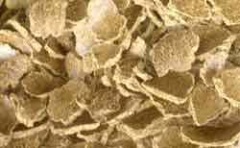Oil Cake
| Infobox on Oil Cake | |
|---|---|
| Example of Oil Cake |  |
| Facts | |
| Origin | - |
| Stowage factor (in m3/t) | - |
| Angle of repose | - |
| Humidity / moisture | - |
| Oil content | - |
| Ventilation | - |
| Risk factors | - |
Oil Cake
Contents
Description
The residue obtained after the expression of vegetable oil from various seeds, beans and nuts. When ground is known as meal. Shipped in bags or in bulk. Used as cattle feed and in the manufacture of fertilizers. A formation of mould may result from contact with water or dampness, in which condition the cake heats up considerably. Subject to loss in weight through drying out. Can be stored without detrimental results for up to six months in hot climates. Longer storage may render the cake mildewy and liable to infestation by weevil. Infestation may commence earlier, depending on whether the store is itself infested.
The majority of oil cakes are subject to heating and spontaneous combustion and represent a considerable fire hazard if not properly prepared and have a high moisture content at the time of bagging. This condition can also be brought about in transit by wet damage and subsequent stowage in a confined space without ventilation, where carbonization of the product often takes place prior to combustion and can be found in isolated bags. These remarks refer to expellers and not extractions, which have a lower moisture content and minimal oil content and are considered far less hazardous, although as vulnerable to deterioration by wet damage.
See also Expellers and Extractions, Seedcake and individual commodity headings.
http://www.tis-gdv.de/tis_e/misc/becker.htm
Reference is also made to the relevant IMO publications of hazardous cargo.











